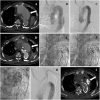Chimney Graft Technique Combined With Embolization for Treating Ruptured Aortic Arch Lesions
- PMID: 34671650
- PMCID: PMC8520930
- DOI: 10.3389/fcvm.2021.711283
Chimney Graft Technique Combined With Embolization for Treating Ruptured Aortic Arch Lesions
Abstract
Background: This study aimed to share the experience in applying the chimney graft technique combined with embolization for treating aortic arch rupture under emergency conditions and evaluating early-term results in these patients. Methods: This study retrospectively included patients with ruptured aortic arch lesions who received the chimney graft technique combined with embolization between March 2016 and March 2021. The primary endpoint was a technical success, deemed as successful stent graft deployment to the planned location, patency of the target branch vessel, and absence of significant type I endoleak. The secondary endpoint was clinical success defined with the size of false lumen in follow-up remaining unchanged or decreasing over time, 30-day mortality, complication, and primary patency of chimney graft. Results: This study included 12 patients (age, 61 ± 12 years; male, 83%). Five patients (42%) received single chimney, one patient (8%) received double chimney, and six patients (50%) received triple chimney. Intraoperative type I endoleak occurred in six patients (50%) who underwent endovascular embolization in the primary operation. Post-operative type I endoleak, evaluated by computed tomography angiography examination following the primary operation, occurred in seven patients (58%), including one patient who received endovascular embolization two times. All patients with post-operative type I endoleak were successfully re-treated using coil and Onyx glue within 1 week, and the median length of stay was 22 ± 11 days (range: 7-44 days). Overall technical success was 100%. Eleven patients had completed their follow-up (median, 12 months, range: 1-34 months), and one patient was out of contact. The 30-day mortality was 9% (1/11, post-operative death of a patient with cerebral hemorrhage). No major complications and no chimney compression, migration, occlusion, or stenosis were recorded during follow-up. Seven patients (58%) have ≥6 months of clinical follow-up time with appropriate imaging. In four (57%) of these patients, diameter stabilization was detected, whereas three (43%) experienced significant reduction (≥5 mm). Conclusion: The patients in this study had satisfactory early-term outcomes. The chimney graft technique combined with coil and Onyx glue embolization may be a safe and effective treatment for ruptured aortic arch lesions under emergency conditions.
Keywords: chimney graft; embolization; endoleak; endovascular treatment; ruptured aortic arch lesions.
Copyright © 2021 Bao, Zhao, Li, Wu, Zeng, Gao, Xu, Feng and Feng.
Conflict of interest statement
The authors declare that the research was conducted in the absence of any commercial or financial relationships that could be construed as a potential conflict of interest.
Figures



Similar articles
-
Thoracic Endovascular Aortic Repair With Single/Double Chimney Technique for Aortic Arch Pathologies.J Endovasc Ther. 2017 Jun;24(3):383-393. doi: 10.1177/1526602817698702. Epub 2017 Mar 21. J Endovasc Ther. 2017. PMID: 28387611
-
Outcomes of thoracic endovascular aortic repair using aortic arch chimney stents in high-risk patients.J Vasc Surg. 2017 Jul;66(1):9-20.e3. doi: 10.1016/j.jvs.2016.11.063. J Vasc Surg. 2017. PMID: 28216358 Free PMC article.
-
Midterm outcomes and evolution of gutter area after endovascular aneurysm repair with the chimney graft procedure.J Vasc Surg. 2018 Jan;67(1):104-112.e3. doi: 10.1016/j.jvs.2017.04.067. Epub 2017 Jun 28. J Vasc Surg. 2018. PMID: 28668275
-
Value and limitations of chimney grafts to treat arch lesions.J Cardiovasc Surg (Torino). 2015 Aug;56(4):503-11. Epub 2015 Mar 13. J Cardiovasc Surg (Torino). 2015. PMID: 25765852 Review.
-
The chimney graft technique for preserving visceral vessels during endovascular treatment of aortic pathologies.J Vasc Surg. 2012 May;55(5):1497-503. doi: 10.1016/j.jvs.2011.10.009. Epub 2012 Jan 10. J Vasc Surg. 2012. PMID: 22236883 Review.
Cited by
-
Primary Intra-operative Embolisation During Urgent Parallel Graft Endovascular Repair in Paravisceral Symptomatic Aortic Pseudoaneurysm.EJVES Vasc Forum. 2024 Nov 13;63:1-10. doi: 10.1016/j.ejvsvf.2024.11.001. eCollection 2025. EJVES Vasc Forum. 2024. PMID: 39803301 Free PMC article.
References
LinkOut - more resources
Full Text Sources

